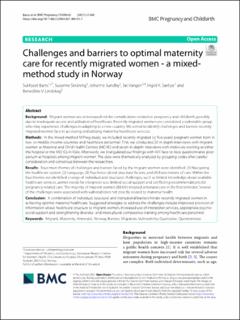Challenges and barriers to optimal maternity care for recently migrated women - a mixed-method study in Norway
Bains, Sukhjeet; Skråning, Susanne; Sundby, Johanne Sommerschild; Vangen, Siri; Sørbye, Ingvil; Lindskog, Benedikte V.
Peer reviewed, Journal article
Published version
Permanent lenke
https://hdl.handle.net/11250/2980901Utgivelsesdato
2021-10-07Metadata
Vis full innførselSamlinger
Originalversjon
BMC Pregnancy and Childbirth. 2021, 21 (1), 1-14. https://doi.org/10.1186/s12884-021-04131-7Sammendrag
Background: Migrant women are at increased risk for complications related to pregnancy and childbirth, possibly due to inadequate access and utilisation of healthcare. Recently migrated women are considered a vulnerable group who may experience challenges in adapting to a new country. We aimed to identify challenges and barriers recently migrated women face in accessing and utilising maternity healthcare services.
Methods: In the mixed-method MiPreg-study, we included recently migrated (≤ fve years) pregnant women born in low- or middle-income countries and healthcare personnel. First, we conducted 20 in-depth interviews with migrant women at Maternal and Child Health Centres (MCHC) and seven in-depth interviews with midwives working at either the hospital or the MCHCs in Oslo. Afterwards, we triangulated our fndings with 401 face-to-face questionnaires post-partum at hospitals among migrant women. The data were thematically analysed by grouping codes after careful consideration and consensus between the researchers.
Results: Four main themes of challenges and barriers faced by the migrant women were identifed: (1) Navigating the healthcare system, (2) Language, (3) Psychosocial and structural factors, and (4) Expectations of care. Within the four themes we identifed a range of individual and structural challenges, such as limited knowledge about available healthcare services, unmet needs for interpreter use, limited social support and conficting recommendations for pregnancy-related care. The majority of migrant women (83.6%) initiated antenatal care in the frst trimester. Several of the challenges were associated with vulnerabilities not directly related to maternal health.
Conclusion: A combination of individual, structural and institutional barriers hinder recently migrated women in achieving optimal maternal healthcare. Suggested strategies to address the challenges include improved provision of information about healthcare structure to migrant women, increased use of interpreter services, appropriate psycho-social support and strengthening diversity- and intercultural competence training among healthcare personnel

